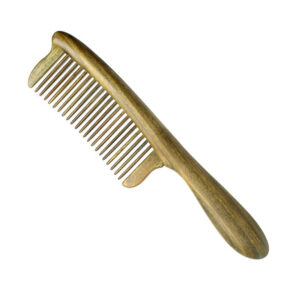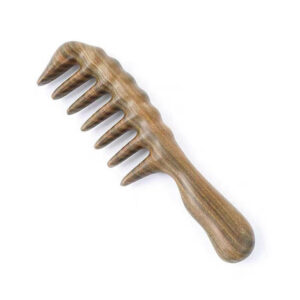

Combs are one of the indispensable daily items in our daily lives. Even the best quality combs require proper cleaning and care to maintain their shine and prolong their life. Cleaning combs is not only to maintain personal hygiene but also to protect the material of the comb from damage caused by the accumulation of dirt and grease. Wrong cleaning methods may damage the comb and shorten its life. What is the best way to clean a comb?
What is the best way to clean a comb?
Different cleaning methods exist for different combs, and each method has unique advantages and limitations.
- Traditional cleaning method: This method usually involves the use of soap and water to clean the comb. It is the most straightforward method, but may not be suitable for all types of combs, especially for those sandalwood combs that require special care.
- Natural cleaning method: This method uses natural ingredients such as baking soda, white vinegar, and lemon juice to clean the comb. These ingredients are not only environmentally friendly but also gentle on the sandalwood material but may require a longer processing time.
- Specialized cleaning methods: There are specialized comb cleaners on the market, which are usually designed for specific materials and can effectively clean the comb without damaging it. However, these cleaners may be more expensive and may not be suitable for daily use.
- Innovative cleaning methods: With the advancement of technology, ultrasonic cleaners have become an innovative cleaning tool. It removes dirt through high-frequency vibration and is suitable for combs made of various materials. However, this method may require specialized equipment and cost more.
Detailed analysis of different methods
1. Traditional cleaning method
Steps: Using warm water and mild soap or shampoo, soak the comb for a few minutes, then gently scrub the teeth and back of the comb with your fingers or a soft cloth, and finally rinse it off with water.
Cleaning effect: This method effectively removes dust and hair from the comb, but may not be effective enough for grease and stubborn dirt.
Applicability and limitation: Suitable for daily quick cleaning, but not suitable for deep cleaning or sandalwood combs with special maintenance needs.
2. Natural cleaning method
Steps: Use a mixture of baking soda and water, or a mixture of white vinegar and water, or even lemon juice, apply it to the comb, scrub gently, and then rinse with water. For particularly dirty combs, you may need to repeat this process a few times.
Cleaning effect: These natural ingredients are gentler on sandalwood and are effective in removing dirt and grease, as well as having some disinfectant properties.
Applicability and limitations: Suitable for those who emphasize on environmental protection and natural ingredients, but may need more time and patience to achieve the desired cleaning effect.
3. Professional cleaning methods
Steps: Purchase a specialized comb cleaner and use it according to the instructions. Usually, the cleaner is applied to the comb, waited a little, and then rinsed with water.
Cleaning effect: Specialized cleaner is designed for comb material, which can deeply clean and protect the comb from damage at the same time.
Applicability and limitations: Suitable for all types of combs, especially those of high grade or requiring special care, but more costly and may not be suitable for frequent use.
4. Innovative cleaning method
Steps: Put the comb into the ultrasonic cleaner and follow the instructions of the device. It usually takes a few minutes and the device will automatically complete the cleaning process.
Cleaning effect: Thoroughly cleans every corner of the comb, including hard-to-reach areas, without causing mechanical damage to the comb.
Applicability and limitations: Suitable for all types of combs, especially those with complex structures or those that are difficult to clean manually. However, specialized equipment needs to be purchased, which is costly and not easy to use daily.
The best way to clean a comb
Of the above 4 kinds of cleaning methods, there is always a suitable one for you, and the one that suits you is the best!
In the case of sandalwood combs, for example, the natural cleaning method is recommended. This method is not only environmentally friendly, but also gentle on the sandalwood material and can effectively clean the comb while maintaining its original luster and durability. Using a mixture of baking soda and lemon juice is the best way to clean sandalwood combs!
1. Reason for choice
- Eco-friendly: Both baking soda and lemon juice are natural ingredients that do not burden the environment.
- Gentle: These two ingredients are very gentle on sandalwood and will not damage the wood structure of the comb.
- Effective: The mixture effectively removes grease, dirt, and odors from the comb, while providing some disinfectant properties.
2. Operation steps
- Prepare materials: baking soda, lemon juice, and a bowl of warm water.
- Mix a spoonful of baking soda and lemon juice to form a paste.
- Apply the mixture to the comb, especially the teeth, and scrub gently with a soft cloth or old toothbrush.
- Place the comb in warm water and gently rub it with your fingers to help remove residual detergent and dirt.
- Thoroughly rinse the comb with clean water to ensure that all cleaning agents have been washed away.
- Place the comb on a clean towel and gently pat dry, then place in a ventilated area to dry.
3. Precautions
- Avoid using too much water when cleaning, as excess water may seep inside the comb and cause deformation or cracking.
- Do not use metal tools for scrubbing to avoid scratching the sandalwood surface.
- Make sure the comb is completely dry after cleaning, as humidity may lead to moldy comb.
- Regular cleaning and maintenance can prolong the life of the comb.
Conclusion
Cleaning your comb is an important part of maintaining personal hygiene and preserving the life of your comb. Choosing the right cleaning method can ensure that the material of the comb will not be damaged while maintaining its original luster and texture. Regardless of the cleaning method, you need to pay attention to the details of the operation to ensure that the cleaning effect extends the life of the comb.
For sandalwood combs in particular, the natural cleaning method of baking soda and lemon juice is used as a best practice. Utilizing the gentle stain-removing ability of baking soda and the natural disinfecting properties of lemon juice, not only can the comb be effectively cleaned, but it is also very gentle on the sandalwood material and will not cause damage or discoloration.
By practicing good comb care habits in your daily life, and through proper cleaning and maintenance methods, your sandalwood comb will last for years to come, adding a natural and elegant touch to your hair care. Remember, a well-cared-for comb not only enhances your image but also honors and passes on traditional craftsmanship.
So, start by owning a sandalwood comb!


